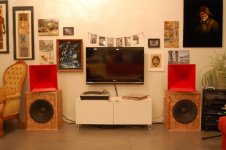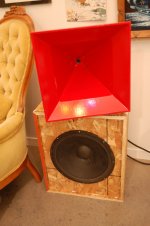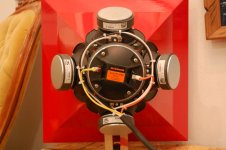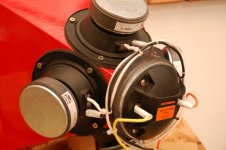You can get a demo version of LspCAD. It has all the features of of the unlimited version, but it doesn't allow saving or exporting.I got my new measurement microphone and started over with much better results. I've found a crossover configuration that I think sounds very nice, but it doesn't have the elusive flat phase response through the crossover region. More fiddling next week.
You can use your new measurement gear to take FR an Imp measurements, and import them into the program.
Then you start up the automatic xover portion of the program. Tell it to give you a flat FR while keeping phase coherence, and let it rip. Just make sure to copy down the output before you shut the program down.
It also has one of (if not the) best manual analog/digital xover builder system.
Now you have a great base to add your own personal touches to.
If you can handle REW and Holm, you can use this as well.
Then pay DSL the royalties necessary to use their patent legitimately for your own profit.
No, they're meant to protect the time and money spent on research and development of something.
I would do that(pay for using the technology). 🙂
Member
Joined 2009
I've found a crossover configuration that I think sounds very nice, but it doesn't have the elusive flat phase response through the crossover region. More fiddling next week.
I don't understand how the phase is supposed to sum up flat. Can somebody explain it real quick or post a link? What is the difference from conventional designs which allows for that?
The mids and woofers are set forward of the tweeter, typically 1/4 WL at crossover points. The mids and woofers are bandpass with an acoustic delay related to the tuned front chambers of each. In the vertical plane they couple together as a point source. If you get things aligned along the axis in terms of phase, you have a very coherent speaker.
I don't understand how the phase is supposed to sum up flat. Can somebody explain it real quick or post a link? What is the difference from conventional designs which allows for that?
Think of phase as the distance traveled by a pulse off of the drivers diaphragm in relation to time. As is how far it travels in a certain amount of time.
The wider the frequency range you can attain a low phase difference the more like a point source this particular type of speaker can behave.
More or less a minimum phase lead or lag is what you are looking for.
Member
Joined 2009
The electronics in the crossover will be causing a phase shift. I don't understand how the drivers arrangement will overcome that assuming some type of Linkwitz-Riley topology (I admit I don't know what crossover is used in the Synergy Horns). If I delay the tweeter in relation to the mids on a conventional, flat baffle 2-way with a LR4 I won't get a flat system phase.
The only instance that I'm aware of where the arrangement of the drivers is used to offset the phase is in a Le'Cleach crossover. It uses 3rd order Butterworth crossover and the driver spacing is carefully calculated from the crossover frequency.
The only instance that I'm aware of where the arrangement of the drivers is used to offset the phase is in a Le'Cleach crossover. It uses 3rd order Butterworth crossover and the driver spacing is carefully calculated from the crossover frequency.
Last edited:
A passive xo for the Synergy would be done with a software optimiser and according to the patent uses non integer order slopes ie not textbook filters. Danley has worked out some requirements that allow the possibility that the xo can be made to achieve coherence.
Member
Joined 2009
So if I understand correctly Tom Danley finds out what degree filter slopes (together with the physical driver delay) result in a flat phase and frequency response. In a conventional design where the drivers don't act as one point source this technique will result in one window in space where the FR and the phase will be good but not outside of that window. In the Synergy Horn the drivers are spaced <1/4 of the crossover wavelength so they sum as a point source and there is effectively no interference between the 2 waveforms (the phase is the same in every direction). Did I get it right?
What insult? What rug? C'mon.....
It would be nice to have a kit for unity horns...FOR us....DIY people....but there is none. Think about that.
Not everybody has the skill to build something like this. Mr Danley makes a few bucks with PA systems, he has no interest in HI-FI. I don't think that bending his patent a little, having as a target the HI-FI and DIY markets will be exactly ....rug steeling. Patent are meant to be broken. And someday, someone will do it.
I've published a few unity horn projects, and intentionally limited them to the car environment because I think Danley should have the opportunity to sell as many subs and speakers as possible. (IE, I don't want to publish a design that could cost him sales.)
I even considered licensing the Unity technology, because I think it would be great to sell a kit. (I haven't done it because I think it's a money-losing proposition.)
I read somewhere that Lambda Acoustics paid next-to-nothing to license the Unity technology. Danley has been way beyond generous when it comes to sharing his knowledge and engineering.
Long story short - if any of you guys are thinking about selling a kit, give Danley a call and license it.
Wonder how much would cost to use the license 🙂. Per piece.
Danley stated what the cost was. I think it was on here. It was beyond trivial - basically the licensing cost was a formality.
And this was back in the day, when Danley didn't own the company! (IIRC, Sound Physics Labs had some type of connection to a NASA contractor, and Danley got involved via his work with acoustic levitation.)
Resurrection
I'm back!
This project isn't dead. My wife and I opened a seasonal gift shop so we have essentially been sleepless for the last few months. It's all packed up now and I finally have time to for hobbies.
When I last worked on the project, I was getting good measurements and everything seemed to be behaving as it should. However, I just didn't think it sounded good. I'm hearing some sort of distortion, but I haven't yet figured out how to get distortion measurements. I've got a couple ideas:
B)Tidy up my rig. I currently have a hodge-podge of consumer and professional gear cobbled together for this experiment which is the source of a good bit of noise and who knows what it could be doing to be signal. Some equipment mergers and acquisitions are in order.
A) Widen my midrange ports. I suspect my ports are too small and are a potential source of distortion. I initially built mine based on data from hancock, but the larger ports used by paulspencer seem to be getting fine results.
I'll post results as I get the ball rolling again.
Oh, and I ordered the kit for this beast. 😀
I'm back!
This project isn't dead. My wife and I opened a seasonal gift shop so we have essentially been sleepless for the last few months. It's all packed up now and I finally have time to for hobbies.
When I last worked on the project, I was getting good measurements and everything seemed to be behaving as it should. However, I just didn't think it sounded good. I'm hearing some sort of distortion, but I haven't yet figured out how to get distortion measurements. I've got a couple ideas:
B)Tidy up my rig. I currently have a hodge-podge of consumer and professional gear cobbled together for this experiment which is the source of a good bit of noise and who knows what it could be doing to be signal. Some equipment mergers and acquisitions are in order.
A) Widen my midrange ports. I suspect my ports are too small and are a potential source of distortion. I initially built mine based on data from hancock, but the larger ports used by paulspencer seem to be getting fine results.
I'll post results as I get the ball rolling again.
Oh, and I ordered the kit for this beast. 😀
That looks kind of familiar.
Yeah, I've been toying around with all sorts of horn/tapped-horn/LLT designs for sub-bass, and when I saw your design I was like 😱 I could set out and try to design something myself, but why bother. You, sir, have raised the bar. It seems we have very similar tastes in sonic transduction!
I had great success tonight! I pulled my surround sound receiver out of the living room so I could keep the signal unbalanced -10 instead of stepping back and forth from +4 to -10. It measures great AND sounds good. Next step will be finishing the other horn and making boxes for the 15"s. I have an AMAZING wife and all of this, bass horn and all, will be going in the living room. I've got a strategy for "integrating" all this into the room. More to come!
I don't understand how the phase is supposed to sum up flat. Can somebody explain it real quick or post a link? What is the difference from conventional designs which allows for that?
Boris,
I am going to take a stab at answering your question in the 'main'* Unity thread here. The phase response of the Synergy is something I've been studying lately and I'd like to keep the discussion in the other thread as it's a good 'reference' these days.
PB
* the 'suitable midrange for a Unity horn' thread
It lives!
Tonight the speakers live!
SO much fun. They sound great. I think Paul Spencer's analogy of the narrow coverage horns to headphones is appropriate - but rather than the image being printed across your forehead as with headphones, it is laid out in front of you. The walls seem to disappear. This lack of room interaction also affords a great deal of detail. I mostly listen to multi-track recordings and only rarely straight 2-mic stereo recordings. This means overly dry recordings (typical of alot of mainstream pop music) can be uncomfortable. On the other hand, well crafted recordings with lots of acoustic detail are a treat. The same goes for dynamics.
On the critical side - high sensitivity speakers are more susceptible to noise. This is made even more apparent by my current kludge of components. I am using the MiniDSP for the mid/high and an old DOD active crossover for the woofers. The mid/high's are powered by a surround receiver and the woofer's by a QSC MX700. Future plans include a passive preamp, another MiniDSP and multiple Tripath kits for amplification. Also, I am working the d220ti drivers way too hard (12db BW @ 1200hz) and hope to replace them with BMS 4550's. When rocking out real hard they sound strained and give a kind of nasal quality to the tone.
Other details: woofers are McCauley 1560b 15"s in 3.5cu.ft sealed enclosures. Sources are my PS3 (as a media server) out to a no-name DAC, and a Technics 1200mk2 through an ATI phono preamp. Paint is candy apple red Rustoleum.
I made measurements of this system in my living room, but REW crashed before I saved and I am enjoying the music too much right now to re-measure.
Tonight the speakers live!
SO much fun. They sound great. I think Paul Spencer's analogy of the narrow coverage horns to headphones is appropriate - but rather than the image being printed across your forehead as with headphones, it is laid out in front of you. The walls seem to disappear. This lack of room interaction also affords a great deal of detail. I mostly listen to multi-track recordings and only rarely straight 2-mic stereo recordings. This means overly dry recordings (typical of alot of mainstream pop music) can be uncomfortable. On the other hand, well crafted recordings with lots of acoustic detail are a treat. The same goes for dynamics.
On the critical side - high sensitivity speakers are more susceptible to noise. This is made even more apparent by my current kludge of components. I am using the MiniDSP for the mid/high and an old DOD active crossover for the woofers. The mid/high's are powered by a surround receiver and the woofer's by a QSC MX700. Future plans include a passive preamp, another MiniDSP and multiple Tripath kits for amplification. Also, I am working the d220ti drivers way too hard (12db BW @ 1200hz) and hope to replace them with BMS 4550's. When rocking out real hard they sound strained and give a kind of nasal quality to the tone.
Other details: woofers are McCauley 1560b 15"s in 3.5cu.ft sealed enclosures. Sources are my PS3 (as a media server) out to a no-name DAC, and a Technics 1200mk2 through an ATI phono preamp. Paint is candy apple red Rustoleum.
I made measurements of this system in my living room, but REW crashed before I saved and I am enjoying the music too much right now to re-measure.
Attachments
Nice work, it's good to finish! I'm not a huge fan of the Selenium driver but the BMS is more like it. It is much more listenable when things get loud.
- Status
- Not open for further replies.
- Home
- Loudspeakers
- Multi-Way
- Unity Horn - budget drivers, active x-over




